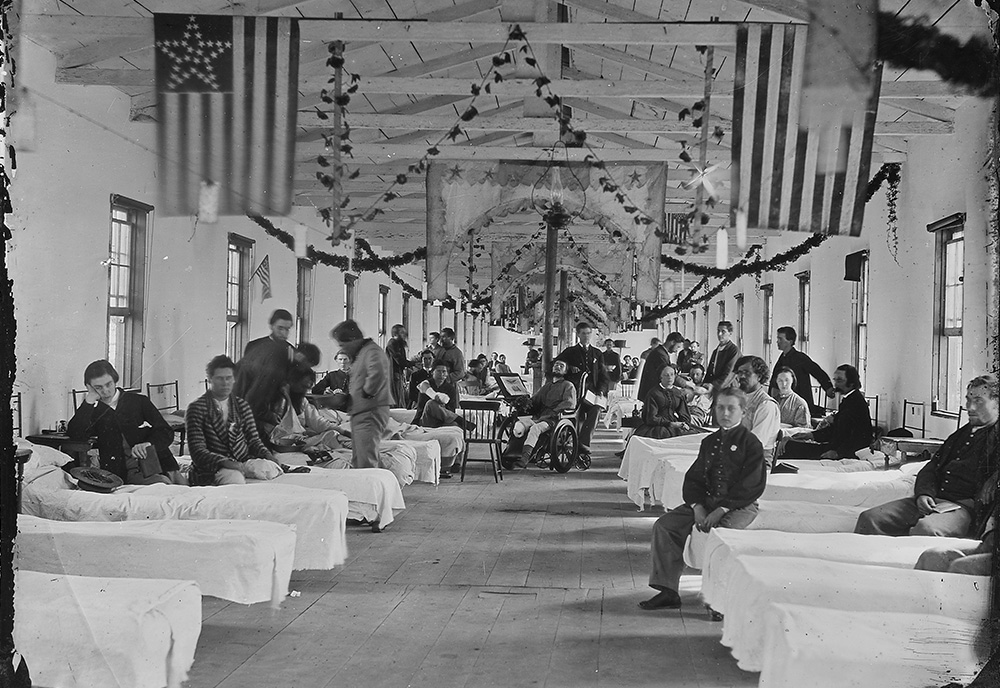Attention A T users. To access the menus on this page please perform the following steps.
1. Please switch auto forms mode to off.
2. Hit enter to expand a main menu option (Health, Benefits, etc).
3. To enter and activate the submenu links, hit the down arrow.
You will now be able to tab or arrow up or down through the submenu options to access/activate the submenu links.
Locator
Contact
Search
VA »
Veterans Health Administration
»
Roots of VA Health Care Started 150 Years Ago
Veterans Health Administration
Roots of VA Health Care Started 150 Years Ago

Civil War era soldier’s hospital
By Hans Petersen
Monday, March 2, 2015
The Department of Veterans Affairs evolved from the first federal Veterans’ facility established for Civil War soldiers and sailors of the Union Army, known initially as the National Asylum for Disabled Volunteer Soldiers.
On March 3, 1865, a month before the Civil War ended, President Abraham Lincoln signed a law to establish a national soldiers and sailor’s asylum. Renamed the National Home for Disabled Volunteer Soldiers in 1873, it was the first government institution in the world created specifically for honorably discharged volunteer soldiers.
The first National Home, known as the Eastern Branch of the National Asylum for Disabled Volunteer Soldiers, opened November 1, 1866, near Augusta, Maine.
As the U.S. entered World War I in 1917, Congress established new benefits for World War I Veterans that included programs for life insurance, disability compensation, prosthetics, vocational rehabilitation, and hospitalization, along with new federal agencies to administer them. Federal Veterans medical care shifted from lifelong residential care to short-term treatment in general or specialized hospitals, supplemented by job re-training or disability pensions.
General Omar Bradley took the reins at VA in August 1945 and steered its transformation into a modern organization. In January 1946, Public Law 293 established VA’s Department of Medicine and Surgery, along with numerous other programs like the VA Voluntary Service to provide better services to Veterans. The law enabled VA to recruit and retain top medical personnel by modifying the civil service system, establishing medical research, and affiliating VA hospitals with medical schools to place Veterans’ medicine on par with the private sector.
VA continues to meet Veterans’ changing medical, surgical and quality-of-life needs.

President Reagan Elevates VA to Cabinet Level
1988 - Veterans Administration becomes Department of Veterans Affairs
VA was elevated to a Cabinet-level executive department by President Ronald Reagan on October 15, 1988. Vice President George H. W. Bush hailed the creation of the new Department, saying, "There is only one place for the Veterans of America, in the Cabinet Room, at the table with the President of the United States of America."
The Veterans Administration was then renamed the Department of Veterans Affairs, but continued to be known by the general public as “the VA.”
VA’s Department of Medicine and Surgery, established in 1946, was renamed as the Veterans Health Services and Research Administration at that time. On May 7, 1991, it was changed to the Veterans Health Administration (VHA).
A "Noble Dream" to Honor Our Patriots
The National Homes were founded on the principles of Florence Nightingale and the U.S. Sanitary Commission. The noble dream of providing care for the nation's patriots began as a simple idea to fill a need in the midst of war in 1863. The public wanted it, Veterans needed it, and our nation's leaders legally authorized it on March 3, 1865. There was no model to follow; this kind of Veterans care didn't exist in the world. What they created was unprecedented.
Today's VHA — the largest of the three administrations that comprise VA — continues to meet Veterans' changing medical, surgical, and quality-of-life needs. New programs provide treatment for traumatic brain injuries, posttraumatic stress, suicide prevention, women Veterans, and more. VA has opened outpatient clinics, and established telemedicine and other services to accommodate a diverse Veteran population, and continues to cultivate ongoing medical research and innovation to improve the lives of America's patriots.
The VA health care system has grown from 54 hospitals in 1930, to include 150 hospitals, 800 community-based outpatient clinics, 126 nursing home care units and 35 domiciliaries.
Check out this website for an extended look at the history of the Department of Veterans Affairs.































